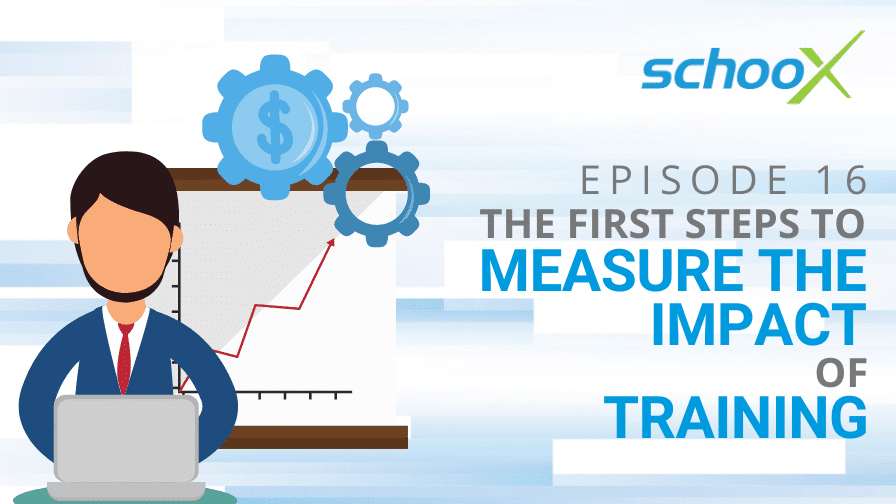01 February 2021
6

Whether you are a learning professional or someone who has been tasked with implementing new training within your organization, you’ve probably been asked to measure and articulate the results by your leaders. This is something that should be expected. After all, it’s important to know that any training courses, regimes, etc., are having an overall beneficial impact on the organization.
But how can you start to measure the impact that training has had on your organization?
You’ll find out in this episode of The Learning Xchange podcast, where Matthew Brown (Schoox’s VP of Learning and Brand Success) talks about how you can get started when it comes to measuring the resulting impact of training on your organization.
Hit play to listen to this episode of The Learning Xchange.
What is the role of learning in your organization?
Measuring and evaluating the impact your training is having on your organization is so important. However, sometimes it can be difficult to find the time and energy to get started. The good news is that you’re not alone. Many people struggle to take the first step when it comes to measuring the quality of training within their organization. Often, we must figure out how to navigate the approach of determining the impact of training and learning.
Proving that your learning activities have had a positive impact on the business is critical. It also helps if the impact can be replicated in the future, further validating the training’s effectiveness in question.
Before you can understand your training’s impact on your organization, you first need to consider the role (or roles) that training plays within the business.
Ask yourself, what is the role of learning within the organization? Here are a few possible roles that may be fulfilled by your training:
- Develop people capabilities
- Uncover needs
- Deliver interventions designed to help team members overcome gaps
- Change behaviors
These are just a few of the possible roles that learning may undertake within your business. There are many more to consider. Most of these roles are all in service of developing people capabilities. However, from a culture perspective, the role of training is also focused on motivating and engaging employees. It can even be leveraged to reinforce a values-based culture within an organization.
You might want to think about how your training can further develop a culture in the business. You may even want to focus your training more strategically and leverage it to maintain the employment brand. When you develop a culture of learning within an organization, it helps create powerful stories that employees can share. Before you know it, you’ve got a team of happy employees who want to tell the world how happy they are working at your organization.
The result? You create a demand, which helps elevate the company and attracts incredible talent to the organization.
How do your employees feel about training?
Do you know how your employees feel about training? Do they love it or hate it? Or, are they somewhat indifferent? Knowing how people feel about the training in your organization is key to driving maximum impact.
If employees don’t enjoy the training, you have to fix it so that you can implement training that employees genuinely love. If your employees already love the training, you’re ready to move on to the next step. Don’t think too much into it if your employees aren’t huge fans of your existing training. They might not have enough experience with training to build an opinion on it. Or, perhaps they have the mindset that training is just another thing to stroke off their to-do list.
Whatever the case may be, you’ve got to try and win over their hearts and minds by creating a training experience that employees feel benefits them and the organization. Understanding how your team feels about training is so important because it can help you take the right action to start implementing training that generates a greater impact.
Begin with the end in mind
Having some sort of plan in mind or vision for the future is hugely beneficial when trying to figure out the impact your training has on your organization. You don’t have to know everything at this point. However, it helps to know what direction you’re headed so that you can make strategic decisions around training and learning to help you stay on course.
When you envision the future, look beyond the first set of measurements you need to capture. You must gather relevant data that proves the training’s impact on the organization. But, then what? Let your mind wander and explore potential possibilities for the future of your training, and its overall impact on the organization.
An easy place to start is the business metrics that the organization really focuses on. You’ll see these metrics pop up in the company’s operating objectives and throughout the organization. To help identify these metrics, just listen! What is everybody talking about? What are the leaders talking about? What is everyone focusing on?
Is the business focusing on customers, creating new products, evolving services, or something related to generating more leads? Take stock, take inventory of all the things your business cares about. From there, take a closer look at each one and figure out which things are underperforming. The thing that is underperforming the most is your low hanging fruit and a great place to start.
Gather data
When gathering data to prove what impact training has had on the organization, ask yourself this important question:
Do you know who you’re trying to impact?
Are you trying to impact employees? Once you’ve identified who you’re trying to impact, think about what you want to impact. Are you trying to close a skill gap? Are you trying to change behaviors or attitudes? Or, perhaps you’re trying to fix a retention issue?
You must know who you’re trying to impact, what you’re trying to impact, and then, you need to figure out how you’re going to make that impact happen. You must know how to get the needle moving towards your end goal.
The final question to consider is how much are you trying to move that needle?
Your answers to these questions will help you understand how to effectively deliver learning to your audience (employees, team members, etc.) and for what purpose. While working on building your program, try to anchor everything back to your answers, which you can view as your guiding principles.
Once you have all of this down, you can start to measure the impact of your training effectively.
We hope that this post helps you to get started and take the first steps towards organizing yourself and your organization so that you can effectively begin to measure the impact of your training. Remember that every journey starts with a single step. You don’t have to take a huge leap to get ahead. This isn’t a marathon. Just take it one step at a time.
RELATED RESOURCES



